

|
Home Updates Hydros Cars Engines Contacts Links Contact On The Wire →Next page |
An ‘Ingenious
Engineer’
B.J. Pilliner
|
|
In 1953, Bernard Pilliner wrote a series of very detailed articles for Model Engineer. He subtitled these "A chronicle of experiments, trials and tribulations." No one that has ever had any connection with flash steam hydroplanes would dispute that they create all of these in equal measure, with a great deal of frustration and untold dedication and hard work thrown in. There also seems to be something in the psyche of the flash steam enthusiast that determines that once they are involved they are hooked for life and unlikely to give up the quest, whatever the difficulties they face. This was certainly true of Bernard, right from his first forays in 1936 through to his sad and untimely death in 1970. Bernard Joseph Pilliner was born in Peckham, London on the 2nd of December 1916 two years after his brother Eric. After the family moved to Harvey Road Guildford, he spent a few months at Charlotteville School before starting at the Royal Grammar School, Guildford in September 1928. Having passed his school certificate in 1933 he gained a four-year apprenticeship at Dennis Bros in Guildford. Dennis was a well-established commercial vehicle manufacturer, best known for their fire engines. Bernard’s apprenticeship started in the last week of November 1933, and from the outset it seems that he had a remarkable talent towards engineering, and design work in particular. |
He spent a great deal of his time in the jig and tool drawing office as well as attending Guildford Technical College on day release and for evening classes, gaining his ONC in the process. During the last year of his apprenticeship, Bernard spent 6 months assisting the works manager. On the completion of his four years, Bernard moved into the jig and tool drawing office permanently where he was involved in the design of all sorts of jigs and tools for the next 2 ½ years.
Whilst still an apprentice Bernard had joined the Guildford Model Engineering Society where he and tethered hydroplane enthusiast Frank Jutton became very closely involved. Bernard had an old Rudge motorbike and used to take Frank on the pillion; every now and again the spark plug connection would pull off and Bernard became skilled at reconnecting it while they were still going along! Before the war, the two men would go to meetings at the pond at Stoke Park, Guildford to run their boats. Frank was running IC engines at that time, but it was to be the mysteries of flash steam that would attract Bernard and dominate his building and racing career from then on. He started building his first flash steam hydroplane around 1936 just as Stan Clifford surrendered his long-standing steam record to the Innocent Brothers and their IC engined ‘Betty’. Unlike the rest of Bernard’s boats, this one did not carry a name and was a relatively conventional, metre long, single step rectangular hull, constructed of tinplate as was common at the time. Bernard’s reasoning for the choice of tinplate- ‘non inflammable’. The steam generator was 33 feet of tubing in two coils, heated by two burners fed from a pressurised fuel tank.
He was to discover very quickly that persuading a flash steamer to run properly requires an incredible amount of work, perseverance and experimentation. At best, the boat, with its twin cylinder poppet valve engine could only manage around 18mph, compared with Stan Clifford’s record of 43mph.
|
As a first attempt at a steamer, the boat was far from a failure, but it was the spur that would see Bernard at the forefront of experimentation and design into the 1950s. In 1937, he passed on his thoughts on making cams via an article in the Model Engineer, the first of many articles he would publish over the years. A new boat and engine were soon on the drawing board as well, and ‘Frisky’ would be completed in 1939, but the outbreak of war would bring the visits to Stoke Park and other venues to a close as the MPBA ended any official boating activities. |
|
Shortly after the start of the war, Bernard left Dennis Bros and moved to the Ministry of Supply HQ in London as a draughtsman where he was involved in secret work with heavy machinery and hydraulics. This lasted 9 months before he was on the move again, this time to Aerolex at Camberley where he took charge of the drawing office designing tools for aircraft production. In January 1942, after a year at Aerolex Bernard was back in Guildford, but this time at Vokes Ltd who specialised in making filters, especially oil, air and fuel filters for aircraft. 1942 brought change of a much more personal nature when in the summer, Bernard married Mary Wales. As well as gaining his technical qualifications, Bernard had also been working towards recognition by the Institution of Mechanical Engineers, starting as a student in 1937 and becoming a graduate in 1938. In January 1943 he was accepted as an Associate Member, becoming B.J. Pilliner. A.M.I.Mech.E. It was certainly an exciting time for the Pilliner's as 1943 would also see the arrival of their first child, Anthony.
With the cessation of hostilities hydroplane racing gradually returned and Bernard was able to continue to experiment with ‘Frisky’. The hull this time was built from plywood and slightly narrower than the previous boat. The boiler was now 40ft of ¼" tubing, still with the same burner arrangement and pressure fed tank. He changed the engine to a single cylinder, still with poppet valve inlet and uniflow exhaust that was coupled to a significantly larger submerged propeller. All this was a great deal more effective with official runs up to 38mph being recorded. The engine was later replaced with a piston valve engine of smaller bore and stroke, which would become his standard design from then on. He considered that the poppet valves were giving rise to valve bounce so ruining the timing and steam admission.
|
The period after the end of the war saw rapid development in several aspects of tethered hydroplane design and it became obvious to Bernard that he would need to incorporate these as well as address the deficiencies that he had noted with ‘Frisky’. It is obvious from his writings, that he looked very closely at very aspect of the flash steam plant and used his considerable design and engineering talents to overcome the problems one by one. All these changes were incorporated in another new boat ‘Ginger’, named after Mary, who had flaming red hair. |
|
‘Ginger’ appeared at the first postwar grand Regatta in 1946 and was smaller and lighter than the previous two boats. A speed of 38mph for 500yds and 33mph for 1000yds would gain Bernard the Crebbin Trophy for the first time. This marvellous trophy was named after 'uncle' Jim Crebbin who was so influential in the world of steam. It is awarded annually for the best run by a steamer initially at the Grand, but now the International Regatta. Strangely, this win is not recorded on the trophy and was unknown until this article was being researched.
|
|
|
The main reason being that Bernard had abandoned the pressurised fuel tank system and was now using a fuel feed pump on the motor. Not only did this mean a much smaller and lighter tank could be used, but fuel flow would be constant throughout a run and dependent on engine speed rather than diminishing air pressure. He also came to the conclusion that the burners were the key to a successful flash steam plant and changed from two to four burners, but with a common vaporising coil within the boiler casing. |
|
|
|
To take advantage of the extra heat he increased the amount of tubing in the boiler to 60ft, but this did not quite work the way he had planned. Bernard was discovering the frustration that every other flash steam enthusiast experiences, that of lack of consistency. ‘Ginger’ experienced all sorts of mechanical breakdowns yet if it did run at top speed, would invariably nose dive into the water. |
|
This would be overcome by a change in hull design brought about by a principle that would become universal, right through to the present day. To the right is the very traditional hull shape with a wide single step and very shallow planing angle. The skeg at the rear is more than two inches under the boat so that the propeller is always completely submerged with the boat running on the front step and rear planing surface of the hull. |
|
|
|
Probably the single most important development in tethered hydroplanes was the move to surface piercing props and hulls with sponsons or planing steps, creating the classic proprider. This reduced resistance significantly so increasing speed dramatically, but it was another series of variables to come to terms with. ‘Ginger’ became a proprider with the addition of two planning skids at the front and one at the stern and a 4" pitch surface prop. These changes upped the speed of the boat from a best of 41mph to just on 50mph, which gives some idea of the advantage of the new principles. |
During the period that ‘Ginger' was under development, the family moved down to Hampshire where daughter Loraine was born in 1948. It was not only in his modelling activities that Bernard was showing such ingenuity and design skill as he was working on all sorts of developments at Vokes and in 1949 he was awarded the first of several world wide patents. The experiments continued on the boat and steam plant, trying to get an even spread of heat in the boiler casing. Bernard faced the same problem as others had with a steamer, that as it goes faster, so the burners are having to work in an ever increasing and turbulent wind which can play havoc with the flames. Bernard referred to it as "the No 1 flash steam ‘bug’ owing to the difficulty of finding out what is happening when the boat is running." Jim Bamford, Frank Jutton and Bernard tried all sorts of ideas for flame tubes, boilers, cowls and shrouds in order to keep the ‘fires burning’. Jim even built his own wind tunnel that was suspended in the door of his shed.
|
In 1951 Bernard produced ‘Frolic’ a boat with ‘daring and original features of design’ and an exercise in lateral thinking. The engine moved to the stern of the boat and mounted horizontally with the drive being taken straight through the transom to what he called a ‘flywheel propeller’ at 6-¾" dia X 10" pitch. This did away with the need for skegs, drive shafts or universal joints, but at the expense of having the heaviest component right at the back. |
|
|
The boat was now virtually all boiler with four burners firing into four coils, all surrounded by a complex casing with hinged air scoops and adjustable flaps. Even so this was not solving the problem as the boat was only reaching about 50mph, so the casing was redesigned to take air directly from the front of the boat and the burners mounted on a spider.
|
|
In this configuration he expected something like a 5mph gain in speed, but on its first run it accelerated to lap at 57, then 61, 65, 68 and finally around 71mph at which stage the boat took off doing comprehensive damage. Bernard considered this experiment a success, as it ‘is the only occasion on which a gain of more than 3 or 4 mph has been made immediately from an alteration.’ Frolic after the accident. In front of the boat is the aluminium front plane. This starts off as one wide plane and then becomes two narrower ones to lift the hull from the water. Rather than a true surface prop, Frolic had two narrow wooden planing surfaces underneath the transom to lift the rear of the boat. |
Having proved the concept, the boat was rebuilt and Bernard then set about solving the next problem, that of keeping the boat on the water. This is nothing new and is still taxing the flash steam runners today. To get a boat weighing 16lbs onto the plane needs a degree of lift in the hull shape. Once the boat is running fast enough, the lift becomes an embarrassment and it takes off and flips. Whether it is a hull like ‘Frolic’ at 70mph or Bob Kirtley’s ‘Pisces II’ at 120mph, the result is the same. Bernard was philosophical about the whole thing, commenting that "one picks up the wreckage and plan for the next season." He did consider slowing the boat down to ‘avoid the flip’, as a ‘boat of moderate speed, which is sufficiently stable and mechanically reliable to finish the course can get results in regattas.’
 |
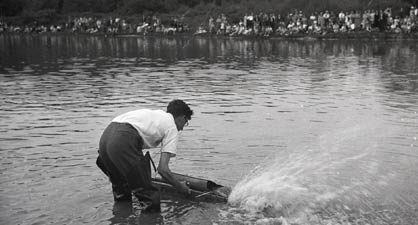 |
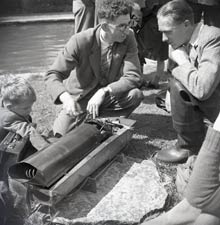 |
| Bernard with Frolic | Bernard & George Lines | |
|
This was the route taken by one regular competitor, but did not necessarily appeal to Bernard so ‘what was wrong with an aerofoil’ he thought? ‘Frolic’ was fitted with a very large aerofoil extending out from the bow of the boat, and the answer came back, ‘plenty’. As he put it, "progress sends in its bill- the boat is allergic to any concrete edged pond on which it bounces and ‘flips’ at around about 50mph, and the aerofoil is torn off and chopped up by the propeller." There were also silencer shrouds in at least three lakes around southern England. |
|
Aerofoils were not to be the answer and were subsequently banned, and so Bernard adopted the method of setting up a boat as used so effectively by Ernie Clark and Arthur Cockman. This was to lift the bridles so that the boat was running on the inside edge only, spilling excess air.
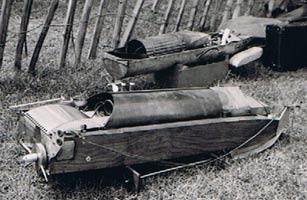 |
 |
As well as raising the bridle attachments, Bernard moved the entire engine unit to the inner side of the hull to keep the prop in the water and added a large fin to aid getting the boat way. Was it any better? No, ‘probably worse’ as it lowered the ‘flip speed’ so ‘after two or three months put everything back where it was. The boat does not flip as it is now only doing about 60-65mph on flat water.’ This all serves to show just what the level of frustration can be trying to get flash steamers to work effectively and reliably. In amongst the difficulties though, there would continue to be competitive runs and regatta successes. One such run in 1952 would give Bernard the prestigious Crebbin Cup for the second time.
|
During the course of all this experimentation Bernard had identified two design features that would become standard practice on the very fastest flash steam boats, but not until considerably later. The first was the concept of burners mounted on a spider with a common vaporising coil inside the boiler case. The second was the venturi flame tube, which unfortunately he dismissed, relying on separate parallel flame tubes around each burner nipple. These two innovations would solve the problem of burner control right up to 120+ mph, are very simple and thrive on high-speed air. |
|
Bernard came to the conclusion that another new boat was needed and ‘something of a compromise between ‘Ginger’ and ‘Frolic’ may be an advantage, still with a rear engine but short shaft and conventional prop.’ (rather than the flywheel) This thinking would result in an entirely new and innovative boat arriving in 1953, ‘Eega Beeva’.
|
The new hull was a radical departure being 42 inches long and instead of a rectangular box was all curves. The bottom was rounded in cross section with the sides curving up tightly to the deck line. As he suggested, Bernard set the engine further forward to allow a steeply inclined transom with a prop shaft exiting through a small rear planing step. While virtually every other tethered hydroplane was now running with two large fixed sponsons at the front, Bernard continued with very shallow planes. |
|
|
|
The ingenious part of the design was that these two planes were pivoted and connected to a lever controlled by the tension on the rear bridle and a third bridle itself attached to the middle of the rear bridle. With the boat at rest, the planes were down to give the hull lift on launching. As the speed increased so the third bridle allowed the rear bridle to straighten out, working a system of levers and springs that raised the planes so that they were level with the bottom of the boat, so reducing the amount of lift from the hull. Left: Boat at speed with sponsons raised fully |
As in Frolic, the engine unit in Eega Beeva was also mounted horizontally. The pumps are mounted on the drive end of the motor with the water pump one side of the reduction gear and the fuel pump on the other. The single cylinder engine is notable in that it has a shuttle piston valve that controls both steam admission and exhaust, rather than a uniflow exhaust common on many other motors. The cylinder with the lid is the displacement lubricator that pumps steam oil directly to the piston valve, just under the steam inlet.
 |
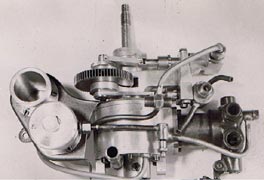 |
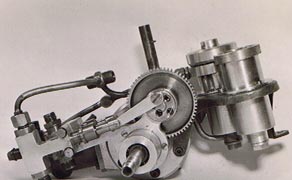 |
| Drive to shuttle piston valve | Steam inlet and exhaust to right | Drive end showing pump reduction gear |
‘Eega Beeva’ made its debut at St Alban’s Regatta where ‘his usual ingenuity and fine work’ were commented on in Model Engineer.The regatta report noted that the boat was ‘obviously very powerful, but suffering from the usual plague of flash steamers, cooling off after a few laps.’
|
|
‘Eega Beeva’ had both burners and boiler fully enclosed in a casing with an air intake at the front and exhaust at the rear giving a lovely smooth and streamlined outline to the boat, but was possibly the Achilles heel of the system. The fastest run of the season at 53.83mph was sufficient to win Bernard the ‘A’ steam class in the 1953 ME Speedboat Competition, his first success. He would also retain the Crebbin Cup for a second year for the best performance by a flash steamer at the Grand Regatta.
|
|
Fine tuning carried on through the 54 season with the new boat gradually becoming faster and faster, finishing 2nd in ‘A’ Class at the International Regatta where it was described as ‘a fearsome aquatic monster’. The boat achieved its first outright success when it won the ‘A’ class at the Southampton Regatta with a speed of 59mph, beating all the IC engined boats in the process. ME commented "this was the best run by a flash steam boat for some time, and it was a wonderful spectacle. |
|
|
|
Just a couple of weeks later at the Grand regatta at Victoria Park, ‘Eega Beeva’ and Bernard would create a ‘spectacle’ that would become an iconic image of tethered hydroplane racing. At just over 60mph the boat took off and Dennis Mattingley captured the exact moment that it was vertical to show the perfect underneath view of the hull and the three-legged bridle system. Although the hull and steam plant survived the somersault, the ‘sponsons were deranged sufficiently to prevent another run being made.’ The 58.77mph run recorded previously would win Bernard the ‘A’ steam class in the Model Engineer Speedboat Competition for the second year running. |
|
Bernard and ‘Eega Beeva’ won the Crebbin Cup again in 1955, but he was attending fewer and fewer regattas as plans were afoot for a much bigger project, not connected to models in any way. He had previously set-up in partnership with two others, Messrs Davies and Palmer as DPP doing engineering/design work. As daughter Loraine recalls, 'For donkeys years every fire appliance you could find had a DPP hosereel assembly on the back, another Pilliner design.' Then, in 1957, Bernard and Mary set up their own company, Rational Automation, to develop and supply automated process machinery to the food production industry. Here he continued with his innovative ideas being awarded several more international patents specifically relating to the baking industry. Some years later they were joined by draughtsman Brian Partridge who would eventually become a partner in the company. In 1968 Bernard was awarded full membership of the Institution of Mechanical Engineers. |
|
Loraine adds 'Rational Automation was an inspired name (my Dad's idea) and rational exactly describes the work he did. He designed and built all kinds of machinery, most of it for the confectionery trade - I grew up wandering in and out of his workshop to see the latest 'mock-ups' and also went up to Jo Lyons with him to see the machines in action. They were fascinating and as kids we made ourselves sick on all the confectionery companies sent to Dad to try out his mock-ups.' The 'Muffin Case Denester' was of particular interest to OTW, being partial to these and their smaller cousin the cupcake. This machine would take individual preformed muffin cases from a stack and place them ready for filling. Bernard Pilliner's patents are all available to view online.
|
|
In 1970 Bernard decided to dust off ‘Eega Beeva’ and have another seasons racing. His old club, Southampton had largely gone over to radio control so he was put in touch with Jim Hampton and became a member of the Hampshire and South Coast Club at the end of June, with the registration HS5. He hoped to have a few trial runs at the Ornamental Lake before travelling to other regattas, but the pole had been destroyed and removed making that impossible. The twelve or so years absence seemed to have made no difference though, and at the Woburn lake he put in what were noted as ‘some very spectacular runs’. |
|
At both the Grand and International Regattas Bernard finished 2nd in the ‘A’ Class, in the process regaining the Crebbin trophy that he last held in 1955. Remarkably, his run was nearly 10mph faster than that in 1955. Bernard and the boat were still competitive, but sadly this was not to be a happy return to the sport. Bernard was very seriously ill, and it is believed this is what prompted him to run his boat for a ‘last season’. Certainly he was unable to attend as many regattas as he had planned, but it was a great shock to the model power boat fraternity when they heard of his sudden death at the end of 1970. Right: Bernard at the Grand in 1970. Daughter Loraine, seated, was promoted to prop flicking duties on this occasion. |
|
|
|
In the obituary by Peter Lambert, Chairman of the MPBA, he wrote, "Bernard was a man who had the respect of us all, his personality and sense of humour at the pond side always added to any regatta he attended. He was the perfect sportsman at all times. The hydroplane world will be the poorer for the loss of such a fine, knowledgeable and experienced engineer." In one of his last commentaries, Edgar Westbury wrote of Bernard and the other flash steam competitors at the 1970 International, "I do not think that there are any more difficult problems in model engineering to be overcome, than in making a flash steam hydroplane perform satisfactorily." Bernard had so nearly achieved this, but his thinking and design ideas would inspire others to continue the quest, culminating in the great flash steam renaissance of the 1980s and 90s. |
Rational Automation, the company that Bernard and Mary set up, continued after his death providing ‘Bernard’s innovative designs to most of the world’s leading bakeries.’ Loraine explained that 'The designs were so good that the company survived on Dad's work for decades after his death, simply by Brian modifying them, as he knew the machines really well by then.' In 1995 the company became part of the BSA- Regal Group.
‘Eega Beeva’, Bernard's last boat, has also survived and was donated to the Auckland Model Engineering Society in New Zealand where Tony Pilliner now lives. It was the society contacting OTW to say they had this boat that started off the whole venture.
 |
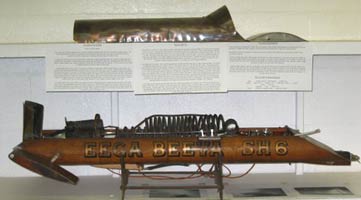 |
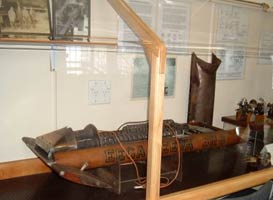 |
| Engine to the right of boiler casing | Boat with sponsons in the fully down position | Eega Beeva on display in the clubhouse |
Eventually we were put in contact with Tony who very kindly provided us with an incredible archive of photographs relating to his late father’s activities and tethered hydroplanes in general. The story does not quite end there as in 1976; Bernard’s widow Mary had married his life long friend and fellow flash steam enthusiast Frank Jutton. Tony ‘volunteered’ his sister Loraine to talk to Frank and Mary to add a more personal perspective to this article. Happily, not only have they been able to do this, but have also provided us with a fascinating account of Frank’s involvement, enabling us to produce a second article detailing his long and remarkable career with tethered hydroplanes.
|
|
|
|
|
|
|
|
||
| 1947 ME Competition | 1954 ME Competition | 1946 Grand Regatta-Crebbin Trophy | 1946 Grand Regatta-Wembley Trophy |
Our sincere thanks go to Tony Pilliner, Loraine Batterbury, Frank and Mary Jutton, Jim Hampton, Rob Bamford, Dennis Mattingley, Peter Hill, Laura Gardner, archivist of the Institution of Mechanical Engineers and Greg Schofield, archivist at Guildford Grammar School.
©copyrightOTW2011